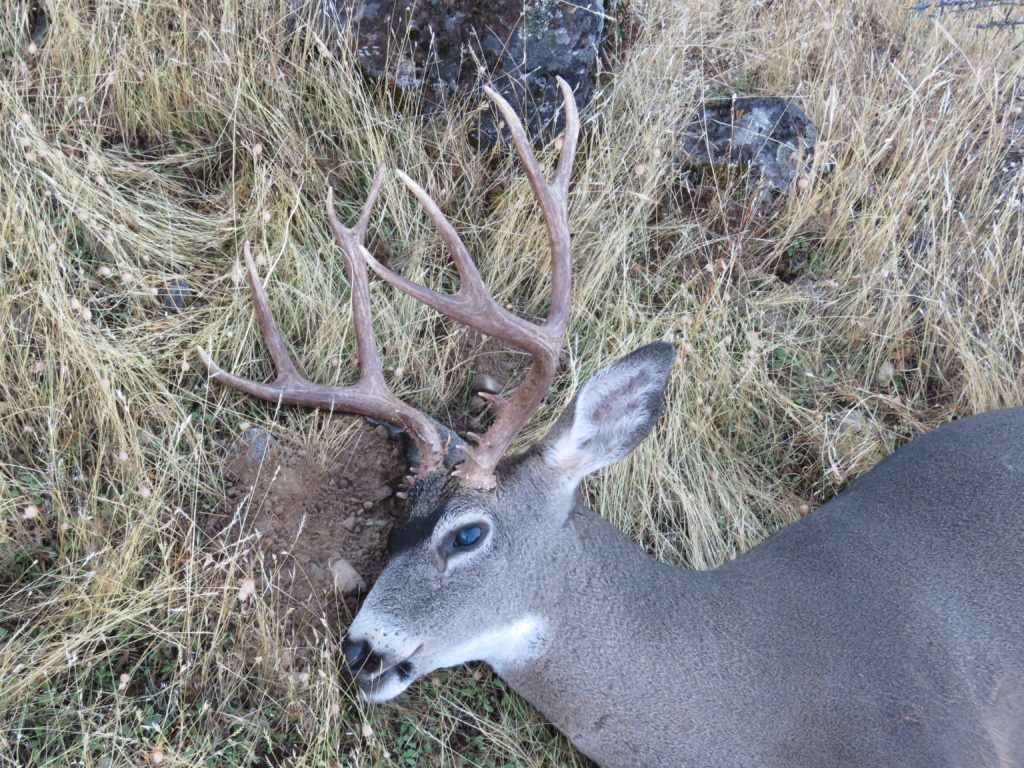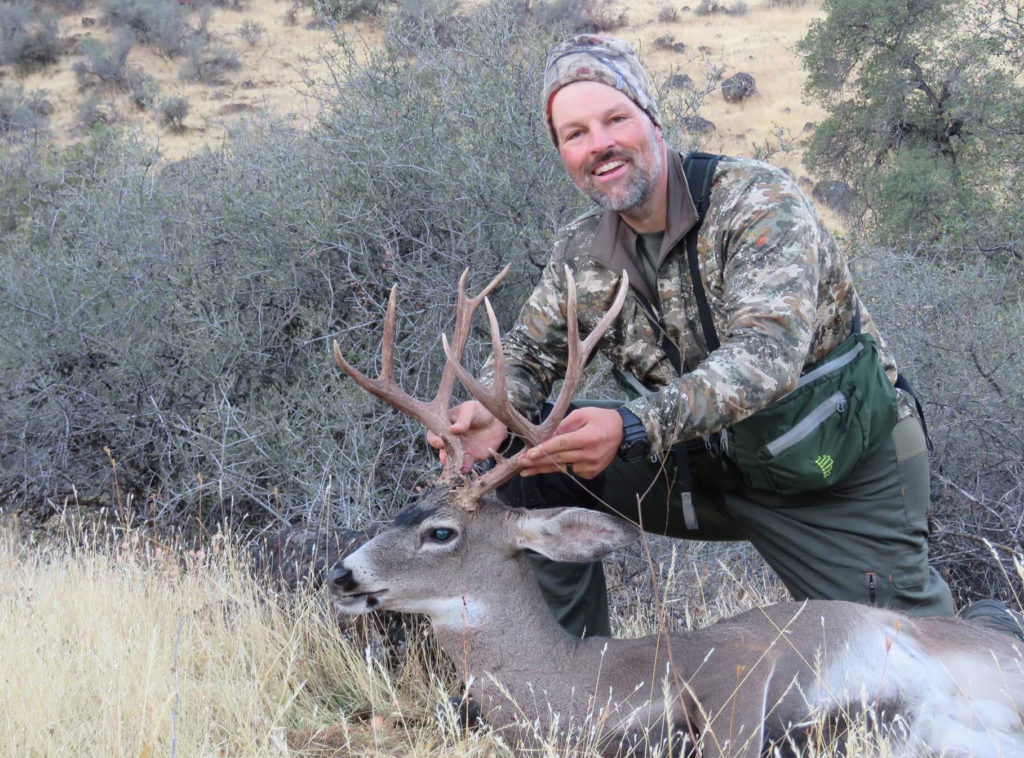Grueling Hunt Leads To ‘Vision Quest’ Buck

The following appears in the October issue of California Sportsman:
By Cal Kellogg
Iinched out to the edge of the rimrock and was careful to stay in the shadows. I didn’t want to be seen.
About 200 yards to my left a narrow spine knifed into the canyon, terminating in a tangled sea of white thorn, oak trees and manzanita near the creek far below.
Down about 150 yards from the top, the spine made a dogleg turn to the south. At that point there was a small flat spot where a gnarled California juniper tree clung to the lava, absorbing enough nutrients from the scant topsoil to survive. The tree’s branches reached nearly to the ground. I’d found the perfect spot.
The tree would give me total concealment. I could lurk beneath those branches in relative comfort while enjoying a commanding view. To the north the country was steep and rugged. There was a lot of cover, but also plenty of open areas.
The shooting might be long, but that summer, in addition to a nonstop grind of physical workouts, I’d performed a good deal of shooting practice with my pet 7mm under field conditions. I was ready!
I’d seen enough and ghosted back from the rims, quietly retreating toward the tiny backpacking tent concealed in a small grove of scrub pines. By the time I reached camp daylight was fading. I gobbled some trail mix, guzzled some water and crawled into the tent. When the sun came up, I’d be at my stand, and if need be, I’d spend the next seven days hiding under that juniper from dawn to dusk.
WHAT HAD BROUGHT ME to this remote spot in the southern Cascades – a full nine hours’ hiking time from my F-150? To answer that question, we’ve got to turn the calendar back 60 months.
Five years before, I’d begun hunting a canyon west of my remote spike camp. There was a good deal of hunting pressure in the canyon, but my post- up-glass-and-wait hunting style served me well, and I was generally able to tag a decent meat buck.
The second year, I noticed one large swath of land that appeared devoid of hunters. Waiting in the predawn darkness, I’d see the flashlight and headlamps of hunters inching into the canyon all around me. To the northeast I’d see the headlights of four-by-fours navigating logging roads. But directly to the east and to the southeast it was always pitch dark. I was intrigued.
I did a little offseason map work and learned that there was a wilderness area and a game refuge to the southeast, which explained the lack of headlights in that direction. The area to the east encompassed several large canyons that ultimately climbed out of the oak woodlands and disappeared into dark timber at about 4,500 feet in elevation. For whatever reason, those canyons were roadless.
“Boy; if a guy wanted to go on an epic blacktail backpack hunt, that would be the place. Lots of deer and zero pressure,” I thought.
But since I was regularly filling tags while hunting out of a comfortable truck camp, I didn’t consider such a hunt too seriously.

“Vast, rugged, roadless and rarely visited” is how Kellogg saw the hunting area that he was attracted to. He was determined to penetrate these remote canyons in search of an epic buck, far away from his truck. (CAL KELLOGG)
AS TIME MARCHED FORWARD, more and more hunters started showing up in my area and of course I was getting older every year. I’d done a good deal of solo backpack hunting with archery gear, so the desire to take on a new challenge slowly grew stronger.
Finally, after four years of hunting my canyon, enough was enough. I didn’t like the increasing hunting pressure and wanted to explore the dark remote canyons while I still had enough steel in my legs to make it happen.
The offseason that year was an exciting blur of planning, running, calisthenics, stretching and trail hiking with a full pack. There was a lava-covered knob atop a ridge in the roadless area I’d been watching. I dubbed it “Knob Ridge.”
Using the knob as a central landmark, I studied the area from every angle using Google Earth. The west face of Knob Ridge looked down on a spring-fed creek and seemed to be dominated by rimrock. About a quarter-mile south of the knob the ridge terminated into a drainage that featured an east-west-running creek that ultimately dropped into the main creek.
The junction of those creeks would be my jumping-off point. I’d travel cross country until I reached the junction, cross the main creek above the tributary, fill all my water bladders and then ascend Knob Ridge and set up a well-hidden camp. Come the last week of October, that’s exactly what I did.
I planned nine days for the hunt. The day before the season opened, I hiked for about six hours with a 60-pound pack and set up the tent for the night. Opening morning, I spent around two hours watching the area where I’d camped, listening to rifles popping off to the west. When things quieted down, I broke camp and was on the move again.
By 1 in the afternoon, 18 liters of water were hanging in the shade, the tent was up and I was taping a small blister on my heel. As I worked, I heard a noise and turned to see a doe and a two-point sneak past less than 50 yards away.
The next morning, I settled in under the juniper while the stars were still shining bright. Working slowly, I set up my ultralight stove for some post-dawn coffee, followed in late afternoon by a dehydrated dinner. Unless I tagged a buck, I wouldn’t be leaving the cover of the stand until the sun was down. The spot was more comfortable than I expected; I could sit, stand and even lay down without showing myself.
Once the sun was up, I used my range finder to get a feel for the area, leaned my pack up against a rock to serve as a shooting rest, and then spent the rest of the day glassing. For the day I spotted 27 deer, including a pair of legal bucks, and a black bear. Both bucks and the bear would have been easy to harvest, but with all the planning and preparation I’d done, I wanted to invest some time in getting an exceptional buck.

MONDAY, TUESDAY AND WEDNESDAY unraveled much like the first day on the stand. I maintained a low profile and saw over 20 deer every day, but nothing I wanted to tag. The weather was fair and mild, and I’d established a pattern. Early in the morning, I’d see deer filtering up from the creek to bed in the shade under the rims. Around noon a few deer would get up and move around and there would be sporadic activity all afternoon as deer browsed and repositioned.
When I slid into my sleeping bag Wednesday night and broke out the Jack Reacher novel I’d been reading, it was noticeably cooler. A small storm was slated for the weekend and I was feeling very optimistic.
The next day was Halloween, and that has always been a lucky deer hunting day for me. Over the years I’d taken some dandy Halloween blacktails, including a 150-plus-inch four-by-four when I was 16 years old. I slid out of the tent early the next morning. I was hungry, so I shoved a pair of my favorite dehydrated meals into the pack: oatmeal and strawberries for breakfast and spaghetti with meat sauce for dinner. Wasting no time, I slid the pack on, grabbed my rifle, hiking sticks and headed for the stand.
Just as it got light enough to see, I spotted two does and two fawns about 125 yards away. The does were feeding and the fawns were milling around. Presently a big gray fox trotted out. The fawns wanted to play, but the fox was having none of it. He shot the quartet of deer with an appraising look and trotted into the brush.
I thought something else might happen and reached into a pouch on the pack and grabbed my video camera. When I looked back up, I saw a lone deer standing at the edge of the brush further up the canyon. Up went the binoculars and my heart skipped a beat.
It was a buck, a big buck. I didn’t wait to count points or any of that. Its antlers were high, and it seemed to have points everywhere. I picked up the 7mm and steadied it over the top of the pack. The buck wasn’t moving or feeding. He was just standing at the edge of the brush, looking and smelling for danger.
I slid the safety off, settled in for a second and the rifle went off. I thought I’d missed at first, because when my eye opened after the shot I could still see the buck in the same spot, but a beat later I realized he was no longer standing. Slowly the buck slumped over onto his right side and I knew I had him.
I sat watching for several minutes just to make sure and tried my best to mark some landmarks to make it easier to find him. Before I left my stand, I zapped the buck with the rangefinder. He was 241 yards away, which is a chip shot for the hunters I watch on YouTube. But for me, that’s a long way and I was pumped!

While not the author’s biggest blacktail, his buck sported a tall and wide four-by-four rack and multiple eye guards. All things considered, he describes the hunt as the best of his life so far. (CAL KELLOGG)
CLIMBING DOWN, NOTHING LOOKED the same. The brush was way higher and thicker than it looked, the ground was steeper and there was a tremendously thick dry creek bed to navigate. It took me about 45 minutes to find the buck, but when I did, I couldn’t believe my eyes.
The buck sported a tall, elegant four-by-four set of antlers with multiple eye guards and the points polished ivory white. Once the adrenaline wore off and the photos were taken, the hard work got started.
I skinned and quartered the buck and packed all the meat back to the spike camp. It took me two days and three trips to get my camp and the deer back to the vehicle, but I spent the winter eating top-notch venison and running my fingers over the beautiful antlers.
Since then, I’ve reflected on the hunt often and I’m blown away how opportunity, planning and luck came together to make for one of the greatest hunts of my life. The hunt was physically challenging. The pack out tested me and left me sore, but the sense of accomplishment I feel hasn’t faded.
If you’re like me and find yourself looking at a remote canyon or scanning a wilderness area on a map thinking, “What if?” come up with a plan, put in the work and pursue your own vision quest. Take it from me; you won’t regret it! CS



